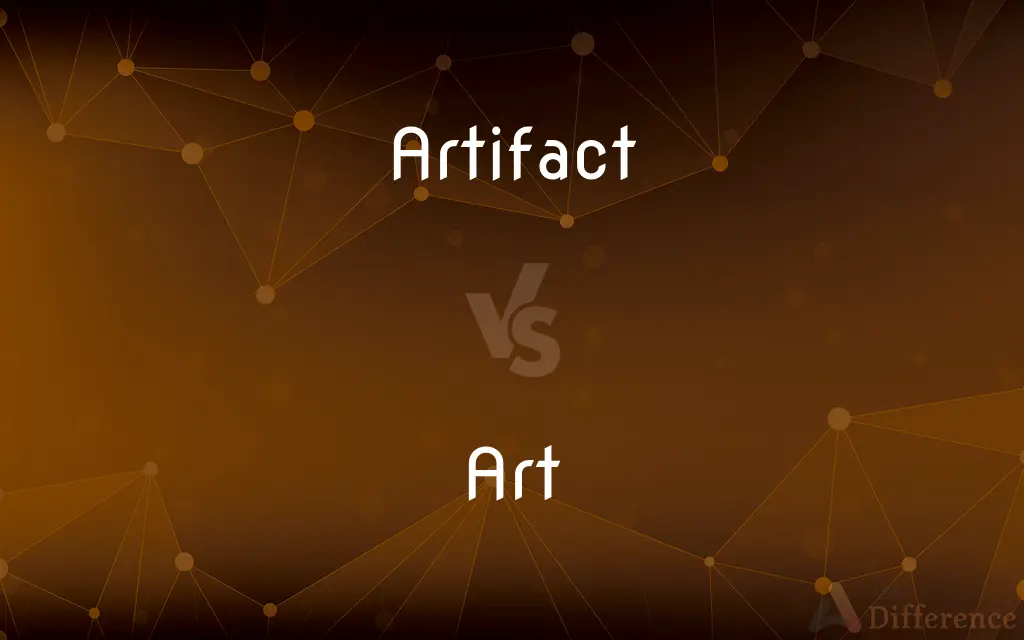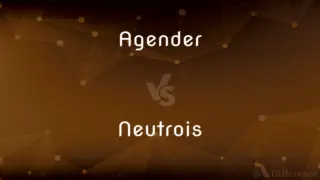Artifact vs. Art — What's the Difference?
Edited by Tayyaba Rehman — By Urooj Arif — Updated on April 8, 2024
"Artifact" refers to objects made by human beings, often of historical or cultural interest, while "Art" embodies creative expression, regardless of medium.

Difference Between Artifact and Art
Table of Contents
ADVERTISEMENT
Key Differences
Artifacts and art represent distinct concepts that intersect in the broad field of human creativity and cultural expression. An artifact is any object made or used by humans, typically with cultural, historical, or archaeological significance. These items can range from ancient tools and clothing to modern technological devices. Art, in contrast, is a manifestation of human creative expression through various mediums such as painting, sculpture, music, and literature, aimed at conveying beauty, emotion, or ideas.
While all art can be considered artifacts due to their creation by humans, not all artifacts are considered art. Artifacts include a broader category of objects that may not have been created with the primary intention of artistic expression but rather for practical use, ceremonial purposes, or everyday activities. Art, however, is created with the intention of expressing the artist's vision, emotions, or conceptual ideas, often evaluated for its aesthetic or intellectual value.
The significance of artifacts often lies in their ability to provide insight into the daily lives, technologies, and cultures of past societies, serving as tangible links to history. Art, while it can also serve as a historical document, is primarily appreciated for its ability to evoke emotional responses, challenge perceptions, or inspire creativity in its audience, transcending time and cultural boundaries.
The context in which objects are presented or perceived can influence whether they are viewed as artifacts or art. For example, an ancient vase may be considered an artifact when placed in an archaeological museum, highlighting its historical and cultural context. The same vase might be seen as a piece of art in a gallery, where its aesthetic qualities and craftsmanship are the focus.
Interpretation plays a significant role in differentiating between artifact and art. Artifacts become subjects of scientific study within fields like anthropology and archaeology, where their origins, uses, and significance are analyzed. Art, while also subject to scholarly analysis, is more often critiqued and appreciated within the realms of art history, criticism, and aesthetics, focusing on its form, style, and impact.
ADVERTISEMENT
Comparison Chart
Definition
Objects made or used by humans, typically with historical or cultural significance.
Human creative expression through mediums like painting, sculpture, music, and literature.
Purpose
Often created for practical use, ceremonial purposes, or as part of daily activities.
Created primarily for aesthetic, emotional, or intellectual expression.
Significance
Provides insight into the technologies, lifestyles, and cultures of past societies.
Valued for its ability to evoke emotions, challenge perceptions, and inspire creativity.
Context
Viewed as artifacts when analyzed for historical and cultural context.
Seen as art when evaluated for aesthetic or conceptual qualities.
Interpretation
Subject of scientific study in fields like archaeology and anthropology.
Analyzed and appreciated in the context of art history, criticism, and aesthetics.
Compare with Definitions
Artifact
Reflects the technological and social aspects of its time.
The artifact reveals much about the daily lives of its creators.
Art
Aimed at conveying an artist's vision, emotions, or conceptual ideas.
The artist's latest work explores themes of identity and belonging.
Artifact
Serves as a tangible link to history.
Each artifact in the collection tells a unique story from the past.
Art
Transcends time and cultural boundaries.
The painting is considered a masterpiece, resonating with audiences worldwide.
Artifact
Often found during archaeological excavations.
The dig site yielded numerous artifacts that will help us understand early human settlements.
Art
A form of creative human expression, producing works to be appreciated primarily for their beauty or emotional power.
The gallery showcases contemporary art that challenges societal norms.
Artifact
Can include tools, clothing, or decorative items from past civilizations.
Archaeologists uncovered artifacts dating back to the Bronze Age.
Art
Encompasses a variety of mediums, including painting, sculpture, literature, and music.
Her art spans multiple mediums but is unified by a common theme.
Artifact
An object made by a human being, typically of historical or cultural interest.
The museum's new exhibit features artifacts from ancient Egypt.
Art
Often evaluated for its aesthetic or intellectual value.
Critics praised the piece for its innovative approach and aesthetic beauty.
Artifact
An object produced or shaped by human craft, especially a tool, weapon, or ornament of archaeological or historical interest.
Art
Art is a diverse range of (and products of) human activities involving creative imagination to express technical proficiency, beauty, emotional power, or conceptual ideas.There is no generally agreed definition of what constitutes art, and ideas have changed over time. The three classical branches of visual art are painting, sculpture, and architecture.
Artifact
Something viewed as a product of human conception or agency rather than an inherent element
"Morality is an artifact of human culture, devised to help us negotiate social relations" (Michael Pollan).
Art
The conscious use of the imagination in the production of objects intended to be contemplated or appreciated as beautiful, as in the arrangement of forms, sounds, or words.
Artifact
A phenomenon or feature not originally present or expected and caused by an interfering external agent, action, or process, as an unwanted feature in a microscopic specimen after fixation, in a digitally reproduced image, or in a digital audio recording.
Art
Such activity in the visual or plastic arts
Takes classes in art at the college.
Artifact
An inaccurate observation, effect, or result, especially one resulting from the technology used in scientific investigation or from experimental error
The apparent pattern in the data was an artifact of the collection method.
Art
Products of this activity; imaginative works considered as a group
Art on display in the lobby.
Artifact
An object made or shaped by human hand or labor.
Art
A field or category of art, such as music, ballet, or literature.
Artifact
An object made or shaped by some agent or intelligence, not necessarily of direct human origin.
Art
A nonscientific branch of learning; one of the liberal arts.
Artifact
Something viewed as a product of human agency or conception rather than an inherent element.
Art
A skill that is attained by study, practice, or observation
The art of negotiation.
Artifact
A finding or structure in an experiment or investigation that is not a true feature of the object under observation, but is a result of external action, the test arrangement, or an experimental error.
The spot on his lung turned out to be an artifact of the X-ray process.
Art
Arts Artful devices, stratagems, and tricks.
Artifact
(archaeology) An object, such as a tool, ornament, or weapon of archaeological or historical interest, especially such an object found at an archaeological excavation.
The dig produced many Roman artifacts.
Art
Artful contrivance; cunning.
Artifact
(biology) An appearance or structure in protoplasm due to death, the method of preparation of specimens, or the use of reagents, and not present during life.
Art
(Printing) Illustrative material, especially in contrast to text.
Artifact
(computing) A perceptible distortion that appears in an audio or video file or a digital image as a result of applying a lossy compression or other inexact processing algorithm.
This JPEG image has been so highly compressed that it has unsightly artifacts, making it unsuitable for the cover of our magazine.
Art
A second person singular present indicative of be.
Artifact
(museology) Any object in the collection of a museum. May be used sensu stricto only for human-made objects, or may include ones that are not human-made.
Art
(uncountable) The conscious production or arrangement of sounds, colours, forms, movements, or other elements in a manner that affects the senses and emotions, usually specifically the production of the beautiful in a graphic or plastic medium.
There is a debate as to whether graffiti is art or vandalism.
Artifact
A product of human workmanship; - applied esp. to the simpler products of aboriginal art as distinguished from natural objects.
Art
(uncountable) The creative and emotional expression of mental imagery, such as visual, auditory, social, etc.
Artifact
Any product of human workmanship; - applied both to objects made for practical purposes as well as works of art. It is contrasted to natural object, i.e. anything produced by natural forces without the intervention of man.
Art
(countable) Skillful creative activity, usually with an aesthetic focus.
She's mastered the art of programming.
Artifact
A structure or appearance in protoplasm due to death, method of preparation of specimens, or the use of reagents, and not present during life.
Art
(uncountable) The study and the product of these processes.
He's at university to study art.
Artifact
An object, oservation, phenomenon, or result arising from hidden or unexpected causes extraneous to the subject of a study, and therefore spurious and having potential to lead one to an erroneous conclusion, or to invalidate the study. In experimental science, artifacts may arise due to inadvertant contamination of equipment, faulty experimental design or faulty analysis, or unexpected effects of agencies not known to affect the system under study.
Art
(uncountable) Aesthetic value.
Her photographs are nice, but there's no art in them.
Artifact
A man-made object taken as a whole
Art
(uncountable) Artwork.
Sotheby's regularly auctions art for millions.
Art collection
Art
(countable) A field or category of art, such as painting, sculpture, music, ballet, or literature.
I'm a great supporter of the arts.
Art
(countable) A nonscientific branch of learning; one of the liberal arts.
Art
(countable) Skill that is attained by study, practice, or observation.
Art
Contrivance, scheming, manipulation.
Art
The second person singular, indicative mode, present tense, of the substantive verb Be; but formed after the analogy of the plural are, with the ending -t, as in thou shalt, wilt, orig. an ending of the second person sing. pret. Cf. Be. Now used only in solemn or poetical style.
Art
The employment of means to accomplish some desired end; the adaptation of things in the natural world to the uses of life; the application of knowledge or power to practical purposes.
Blest with each grace of nature and of art.
Art
A system of rules serving to facilitate the performance of certain actions; a system of principles and rules for attaining a desired end; method of doing well some special work; - often contradistinguished from science or speculative principles; as, the art of building or engraving; the art of war; the art of navigation.
Science is systematized knowledge . . . Art is knowledge made efficient by skill.
Art
The systematic application of knowledge or skill in effecting a desired result. Also, an occupation or business requiring such knowledge or skill.
The fishermen can't employ their art with so much success in so troubled a sea.
Art
The application of skill to the production of the beautiful by imitation or design, or an occupation in which skill is so employed, as in painting and sculpture; one of the fine arts; as, he prefers art to literature.
Art
Those branches of learning which are taught in the academical course of colleges; as, master of arts.
In fearless youth we tempt the heights of arts.
Four years spent in the arts (as they are called in colleges) is, perhaps, laying too laborious a foundation.
Art
Learning; study; applied knowledge, science, or letters.
So vast is art, so narrow human wit.
Art
Skill, dexterity, or the power of performing certain actions, acquired by experience, study, or observation; knack; as, a man has the art of managing his business to advantage.
Art
Skillful plan; device.
They employed every art to soothe . . . the discontented warriors.
Art
Cunning; artifice; craft.
Madam, I swear I use no art at all.
Animals practice art when opposed to their superiors in strength.
Art
The black art; magic.
In America, literature and the elegant arts must grow up side by side with the coarser plants of daily necessity.
Art
The products of human creativity; works of art collectively;
An art exhibition
A fine collection of art
Art
The creation of beautiful or significant things;
Art does not need to be innovative to be good
I was never any good at art
He said that architecture is the art of wasting space beautifully
Art
A superior skill that you can learn by study and practice and observation;
The art of conversation
It's quite an art
Art
Photographs or other visual representations in a printed publication;
The publisher was responsible for all the artwork in the book
Common Curiosities
Can a practical object be considered art?
Yes, practical objects can be considered art if they are created with the intention of aesthetic or emotional expression, or if they are appreciated for their design and beauty.
How do archaeologists differentiate between artifacts and art?
Archaeologists may classify objects as artifacts based on their historical and cultural context, focusing on their use and significance to past societies, whereas art is analyzed for its creative expression and aesthetic value.
Can art be considered an artifact?
Yes, art can be considered an artifact as it is created by humans and can hold historical or cultural significance.
What is the primary difference between artifact and art?
The primary difference lies in their purpose: artifacts are often created for practical use or as part of daily activities, while art is created for aesthetic, emotional, or intellectual expression.
What qualifies as an artifact?
An artifact is any object made or used by humans, typically of historical or cultural interest, such as tools, clothing, or ceremonial items.
Why is the context important in distinguishing between artifact and art?
Context helps determine the value and significance of an object, whether it's appreciated for its historical and cultural insights as an artifact, or for its aesthetic and emotional impact as a piece of art.
Can the same object be both an artifact and a piece of art?
Yes, the same object can be both an artifact and a piece of art, depending on its historical significance, the intent behind its creation, and how it is perceived and valued by society.
How does interpretation affect our understanding of artifacts and art?
Interpretation affects understanding by providing insights into the origins, uses, and significance of artifacts, and by offering perspectives on the aesthetic, emotional, or conceptual qualities of art.
What role do museums play in presenting artifacts and art?
Museums play a crucial role in preserving and presenting both artifacts and art, offering educational and cultural contexts that help audiences understand and appreciate their significance.
How do societal values influence the classification of objects as artifacts or art?
Societal values influence classification by determining what is considered important or valuable to preserve and study as artifacts, or to celebrate and critique as art, reflecting cultural priorities and aesthetic standards.
Share Your Discovery

Previous Comparison
Agender vs. Neutrois
Next Comparison
Owe vs. DebtAuthor Spotlight
Written by
Urooj ArifUrooj is a skilled content writer at Ask Difference, known for her exceptional ability to simplify complex topics into engaging and informative content. With a passion for research and a flair for clear, concise writing, she consistently delivers articles that resonate with our diverse audience.
Edited by
Tayyaba RehmanTayyaba Rehman is a distinguished writer, currently serving as a primary contributor to askdifference.com. As a researcher in semantics and etymology, Tayyaba's passion for the complexity of languages and their distinctions has found a perfect home on the platform. Tayyaba delves into the intricacies of language, distinguishing between commonly confused words and phrases, thereby providing clarity for readers worldwide.
















































